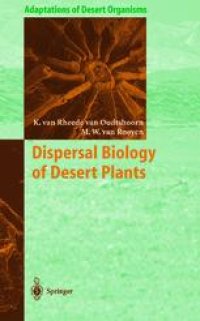
Ebook: Dispersal Biology of Desert Plants
- Tags: Plant Sciences, Ecology, Agriculture, Forestry
- Series: Adaptations of Desert Organisms
- Year: 1999
- Publisher: Springer-Verlag Berlin Heidelberg
- Edition: 1
- Language: English
- pdf
Dispersal processes, i.e. those processes occurring between the time of seed maturation and germination, have important effects on plant distribution and abundance.
Although adaptations to long range dispersal (telechory) are by no means rare in desert plants, many desert plant species do not possess any features to promote dispersal (atelechory), while others have structures that hamper dispersal (antitelechory). The high frequency with which atelechorous and antitelechorous mechanisms are present in plants inhabiting arid areas indicates the importance of these adaptations. Among the benefits derived from these adaptations are the spreading of germination over time, the provision of suitable conditions for germination and subsequent seedling establishment and the maintenance of a reservoir of available seeds.
This book describes the ways and means - anatomical, morphological and ecological - by which dispersal in desert plants has evolved to ensure the survival of these species in their harsh and unpredictable environment.
Dispersal processes, i.e. those processes occurring between the time of seed maturation and germination, have important effects on plant distribution and abundance.
Although adaptations to long range dispersal (telechory) are by no means rare in desert plants, many desert plant species do not possess any features to promote dispersal (atelechory), while others have structures that hamper dispersal (antitelechory). The high frequency with which atelechorous and antitelechorous mechanisms are present in plants inhabiting arid areas indicates the importance of these adaptations. Among the benefits derived from these adaptations are the spreading of germination over time, the provision of suitable conditions for germination and subsequent seedling establishment and the maintenance of a reservoir of available seeds.
This book describes the ways and means - anatomical, morphological and ecological - by which dispersal in desert plants has evolved to ensure the survival of these species in their harsh and unpredictable environment.
Dispersal processes, i.e. those processes occurring between the time of seed maturation and germination, have important effects on plant distribution and abundance.
Although adaptations to long range dispersal (telechory) are by no means rare in desert plants, many desert plant species do not possess any features to promote dispersal (atelechory), while others have structures that hamper dispersal (antitelechory). The high frequency with which atelechorous and antitelechorous mechanisms are present in plants inhabiting arid areas indicates the importance of these adaptations. Among the benefits derived from these adaptations are the spreading of germination over time, the provision of suitable conditions for germination and subsequent seedling establishment and the maintenance of a reservoir of available seeds.
This book describes the ways and means - anatomical, morphological and ecological - by which dispersal in desert plants has evolved to ensure the survival of these species in their harsh and unpredictable environment.
Content:
Front Matter....Pages I-XII
Background....Pages 1-6
Zoochory....Pages 7-32
Anemochory....Pages 33-68
Hydrochory....Pages 69-80
Autochory....Pages 81-91
Restriction of Dispersal Due to Reduction of Dispersal Structures....Pages 93-119
Restriction of Dispersal Due to Anchorage Mechanisms....Pages 121-142
Restriction of Dispersal in Time....Pages 143-167
Dispersal Spectra....Pages 169-181
Seed Dispersal and Population Dynamics....Pages 183-200
Back Matter....Pages 201-242
Dispersal processes, i.e. those processes occurring between the time of seed maturation and germination, have important effects on plant distribution and abundance.
Although adaptations to long range dispersal (telechory) are by no means rare in desert plants, many desert plant species do not possess any features to promote dispersal (atelechory), while others have structures that hamper dispersal (antitelechory). The high frequency with which atelechorous and antitelechorous mechanisms are present in plants inhabiting arid areas indicates the importance of these adaptations. Among the benefits derived from these adaptations are the spreading of germination over time, the provision of suitable conditions for germination and subsequent seedling establishment and the maintenance of a reservoir of available seeds.
This book describes the ways and means - anatomical, morphological and ecological - by which dispersal in desert plants has evolved to ensure the survival of these species in their harsh and unpredictable environment.
Content:
Front Matter....Pages I-XII
Background....Pages 1-6
Zoochory....Pages 7-32
Anemochory....Pages 33-68
Hydrochory....Pages 69-80
Autochory....Pages 81-91
Restriction of Dispersal Due to Reduction of Dispersal Structures....Pages 93-119
Restriction of Dispersal Due to Anchorage Mechanisms....Pages 121-142
Restriction of Dispersal in Time....Pages 143-167
Dispersal Spectra....Pages 169-181
Seed Dispersal and Population Dynamics....Pages 183-200
Back Matter....Pages 201-242
....